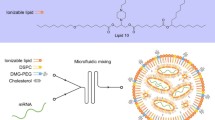Abstract
The silencing of specific oncogenes via RNA interference (RNAi) holds great promise for the future of cancer therapy. RNAi is commonly carried out using small interfering RNA (siRNA) composed of a 19 bp duplex region with a 2-nucleotide overhang at each 3′ end. This classical siRNA structure, however, can trigger non-specific effects, which has hampered the development of specific and safe RNAi therapeutics. Previously, we developed a novel siRNA structure, called asymmetric shorter-duplex siRNA (asiRNA), which did not cause the non-specific effects triggered by conventional siRNA, such as off-target gene silencing mediated by the sense strand. In this study, we first screened potent asiRNA molecules targeting the human c-MET gene, a promising anticancer target. Next, the activity of a selected asiRNA was further optimized by introducing a locked nucleic acid (LNA) to maximize the gene silencing potency. The optimized asiRNA targeted to c-MET may have potential as a specific and safe anticancer RNAi therapeutic.
Similar content being viewed by others
References
Chang, C.I., Yoo, J.W., Hong, S.W., Lee, S.E., Kang, H.S., Sun, X., Rogoff, H.A., Ban, C., Kim, S., Li, C.J., et al. (2009). Asymmetric shorter-duplex siRNA structures trigger efficient gene silencing with reduced nonspecific effects. Mol. Ther. 17, 725–732.
Chang, C.I., Kim, H.A., Dua, P., Kim, S., Li, C.J., and Lee, D.K. (2011). Structural diversity repertoire of gene silencing small interfering RNAs. Nucleic Acid Ther. 21, 125–131.
Christensen, J.G., Burrows, J., and Salgia, R. (2005). c-Met as a target for human cancer and characterization of inhibitors for therapeutic intervention. Cancer Lett. 225, 1–26.
Chu, C.Y., and Rana, T.M. (2008). Potent RNAi by short RNA triggers. RNA 14, 1714–1719.
Clark, P.R., Pober, J.S., and Kluger, M.S. (2008). Knockdown of TNFR1 by the sense strand of an ICAM-1 siRNA: dissection of an off-target effect. Nucleic Acids Res. 36, 1081–1097.
Cooper, C.S., Park, M., Blair, D.G., Tainsky, M.A., Huebner, K., Croce, C.M., and Vande Woude, G.F. (1984). Molecular cloning of a new transforming gene from a chemically transformed human cell line. Nature 311, 29–33.
Davidson, B.L., and McCray, P.B., Jr. (2011). Current prospects for RNA interference-based therapies. Nat. Rev. Genet. 12, 329–340.
Elbashir, S.M., Harborth, J., Lendeckel, W., Yalcin, A., Weber, K., and Tuschl, T. (2001a). Duplexes of 21-nucleotide RNAs mediate RNA interference in cultured mammalian cells. Nature 411, 494–498.
Elbashir, S.M., Martinez, J., Patkaniowska, A., Lendeckel, W., and Tuschl, T. (2001b). Functional anatomy of siRNAs for mediating efficient RNAi in Drosophila melanogaster embryo lysate. EMBO J. 20, 6877–6888.
Fedorov, Y., Anderson, E.M., Birmingham, A., Reynolds, A., Karpilow, J., Robinson, K., Leake, D., Marshall, W.S., and Khvorova, A. (2006). Off-target effects by siRNA can induce toxic phe-notype. RNA 12, 1188–1196.
Gaglione, M., and Messere, A. (2010). Recent progress in chemically modified siRNAs. Mini-Rev. Med. Chem. 10, 578–595.
Grimm, D. (2009). Small silencing RNAs: state-of-the-art. Adv. Drug Deliv. Rev. 61, 672–703.
Hannon, G.J. (2002). RNA interference. Nature 418, 244–251.
Hong, S.W., Yoo, J.W., Kang, H.S., Kim, S., and Lee, D.K. (2009). HIF-1alpha-dependent gene expression program during the nucleic acid-triggered antiviral innate immune responses. Mol. Cells 27, 243–250.
Jackson, A.L., and Linsley, P.S. (2010). Recognizing and avoiding siRNA off-target effects for target identification and therapeutic application. Nat. Rev. Drug Discov. 9, 57–67.
Karolchik, D., Hinrichs, A.S., Furey, T.S., Roskin, K.M., Sugnet, C.W., Haussler, D., and Kent, W.J. (2004). The UCSC Table Browser data retrieval tool. Nucleic Acids Res. 32, D493–496.
Kaur, H., Arora, A., Wengel, J., and Maiti, S. (2006). Thermodynamic, counterion, and hydration effects for the incorporation of locked nucleic acid nucleotides into DNA duplexes. Biochemistry 45, 7347–7355.
Kleinman, M.E., Yamada, K., Takeda, A., Chandrasekaran, V., Nozaki, M., Baffi, J.Z., Albuquerque, R.J., Yamasaki, S., Itaya, M., Pan, Y., et al. (2008). Sequence- and target-independent angiogenesis suppression by siRNA via TLR3. Nature 452, 591–597.
Ma, P.C., Maulik, G., Christensen, J., and Salgia, R. (2003). c-Met: structure, functions and potential for therapeutic inhibition. Cancer Metastasis Rev. 22, 309–325.
Sano, M., Sierant, M., Miyagishi, M., Nakanishi, M., Takagi, Y., and Sutou, S. (2008). Effect of asymmetric terminal structures of short RNA duplexes on the RNA interference activity and strand selection. Nucleic Acids Res. 36, 5812–5821.
Sun, X., Rogoff, H.A., and Li, C.J. (2008). Asymmetric RNA duplexes mediate RNA interference in mammalian cells. Nat. Biotechnol. 26, 1379–1382.
van Dongen, S., Abreu-Goodger, C., and Enright, A.J. (2008). Detecting microRNA binding and siRNA off-target effects from expression data. Nat. Methods 5, 1023–1025.
Vester, B., and Wengel, J. (2004). LNA (locked nucleic acid): highaffinity targeting of complementary RNA and DNA. Biochemistry 43, 13233–13241.
Yoo, J.W., Hong, S.W., Kim, S., and Lee, D.K. (2006). Inflammatory cytokine induction by siRNAs is cell type- and transfection reagent-specific. Biochem. Biophys. Res. Commun. 347, 1053–1058.
Author information
Authors and Affiliations
Corresponding author
Additional information
These authors contributed equally to this work.
About this article
Cite this article
Jo, Sg., Hong, S.W., Yoo, J.W. et al. Selection and optimization of asymmetric siRNA targeting the human c-MET gene. Mol Cells 32, 543–548 (2011). https://doi.org/10.1007/s10059-011-0160-1
Received:
Revised:
Accepted:
Published:
Issue Date:
DOI: https://doi.org/10.1007/s10059-011-0160-1




